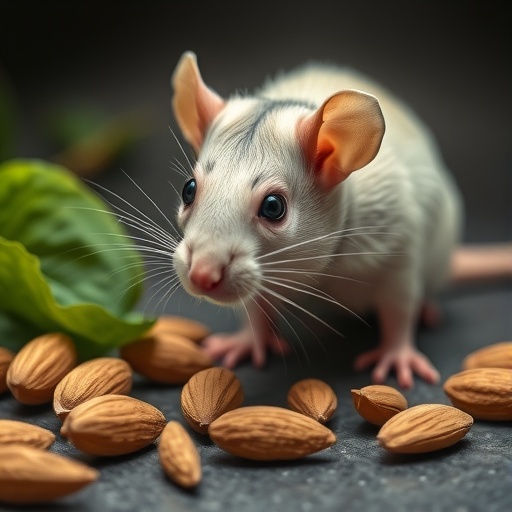In a groundbreaking study published in the renowned journal “Environmental Science and Pollution Research,” researchers Shahbaz, Zubair, and Riaz explore the testicular protective effects of Prunus amygdalus, commonly known as the almond tree, combined with zinc against the detrimental impacts of cadmium-induced toxicity in rats. With rising global concerns surrounding environmental pollutants, particularly heavy metals like cadmium, this research sheds light on potential avenues to mitigate reproductive toxicity linked to such substances.
Cadmium, a highly toxic metal, is widely recognized for its adverse health effects, particularly in terms of male reproductive health. The accumulation of cadmium in the body can lead to various health problems, including infertility and other severe reproductive disorders. The current study opens a crucial dialogue regarding the protective properties of natural compounds and essential elements in combatting these effects, presenting a significant breakthrough in environmental health research.
The mechanism by which cadmium exerts these toxic effects involves oxidative stress, inflammation, and cellular apoptosis. When exposed to cadmium, the body produces an excess of reactive oxygen species (ROS), which can wreak havoc on cellular structures, including DNA, proteins, and lipids. This contributes to testicular damage, which is characterized by degeneration of the seminiferous tubules and impaired sperm production. The implications of such toxicity extend beyond the individual, leading to broader reproductive health concerns within entire populations.
Researchers are now emphasizing the potential of natural antioxidants to combat oxidative damage caused by cadmium exposure. This research surveyed Prunus amygdalus, known for its richness in flavonoids and other phenolic compounds, which are recognized for their antioxidant capabilities. The findings indicate that the phytochemicals present in almonds may play a vital role in reversing oxidative stress and reducing inflammation, ultimately leading to improved testicular health.
Moreover, zinc is highlighted in the study as an essential micronutrient that is crucial for numerous biological functions, including DNA synthesis and regulation of gene expression. It has long been understood that zinc deficiency correlates with impaired testicular function, making this mineral a prime candidate for investigation alongside Prunus amygdalus. The synergistic effects of combining zinc with almond extracts could provide a multifaceted approach to detoxifying cadmium-induced damage in reproductive tissues.
Through a series of meticulously designed experiments involving male rats, the researchers were able to ascertain the real-world efficacy of their proposed treatment regimen. Subjecting the rats to controlled cadmium exposure modeled the environmental threat faced in various industrial contexts, while the subsequent administration of Prunus amygdalus and zinc aimed to evaluate their protective effects. Behavioral tests, biochemical assays, and histopathological evaluations were employed to measure outcomes related to testicular function and overall health.
The results of the study were striking, revealing that the co-administration of zinc and almond extracts significantly alleviated the negative effects induced by cadmium. Observed improvements included enhanced sperm quality, better testicular morphology, and diminished oxidative stress markers. This evidence supports the notion that dietary inclusion of such natural products could serve as a preventive measure against cadmium’s damaging effects on male fertility.
While the study offers promising results, it also raises important questions regarding the practical implications of these findings. Can a consistent dietary intake of almonds and zinc effectively reduce cadmium toxicity in humans? Further research will be necessary to assess the translational potential of these protective effects and the feasibility of recommending such dietary practices among populations susceptible to heavy metal exposure.
As the discourse surrounding environmental health continues to evolve, the implications of this study align with a growing body of research advocating for the integration of dietary modifications as a strategy to mitigate the harmful effects of pollutants. This aligns perfectly with the public health goals surrounding reproductive health, especially concerning the rising concerns of infertility rates attributed to environmental exposure.
Adopting a holistic approach that incorporates both dietary interventions and public awareness regarding heavy metal exposure could play a pivotal role in promoting wellness. The current study serves as a vital piece in understanding how we might leverage both nature’s bounty and nutrition to combat chemical exposures that threaten reproductive health.
Looking ahead, the integration of such findings into public health policy could create a pathway for mitigating future risks associated with environmental pollutants like cadmium. This study invites further exploration into the protective role of natural compounds, potentially inspiring a new wave of preventive health strategies aimed at safeguarding male reproductive health against toxicity.
The current research encapsulates an essential step forward, not only in our understanding of cadmium toxicity but also in mapping out natural solutions that promote health and well-being. Environmental and reproductive health intersect in ways that demand our attention, and studies like this represent a critical avenue for exploration as we seek to create a safer, healthier future for upcoming generations.
This groundbreaking work emphasizes the importance of continuing to investigate natural therapies that could offer a protective shield against environmental toxins. In an age where industrialization and pollution are on the rise, understanding and harnessing nature’s potential becomes more vital than ever.
With compelling evidence advocating for the protective properties of Prunus amygdalus and zinc against cadmium toxicity, moving forward, experts in environmental health and nutrition are encouraged to explore these findings, seek innovative solutions, and advocate for the integration of these dietary aspects into health recommendations.
Subject of Research:
The protective effects of Prunus amygdalus and zinc against cadmium-induced toxicity in rats.
Article Title:
Evaluation of testicular protective effects of Prunus amygdalus and zinc against cadmium induced toxicity in rats.
Article References:
Shahbaz, A.T., Zubair, F., Riaz, N. et al. Evaluation of testicular protective effects of Prunus amygdalus and zinc against cadmium induced toxicity in rats.
Environ Sci Pollut Res (2025). https://doi.org/10.1007/s11356-025-36973-5
Image Credits:
AI Generated
DOI:
10.1007/s11356-025-36973-5
Keywords:
Cadmium, Prunus amygdalus, zinc, reproductive health, oxidative stress, antioxidants, testicular toxicity, environmental pollutants.




